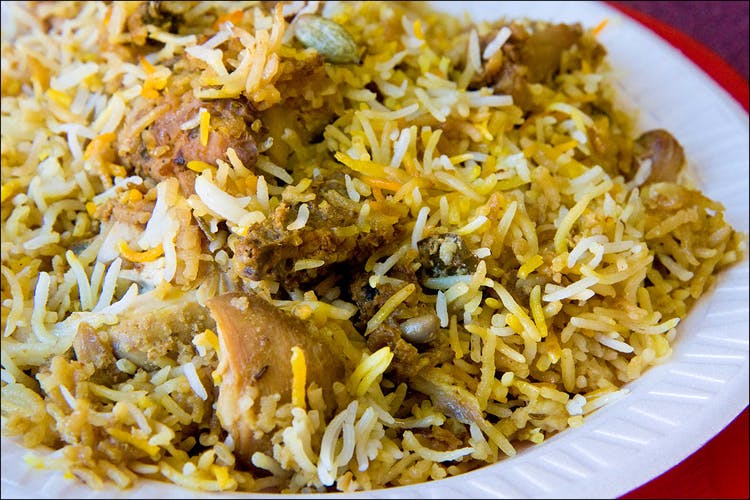I’ve asked this question to several people, and by the end of it, I’m even more confused than when I started out. Marut Sikka, food impresario, says with great conviction that pulao is made when rice and meat or vegetables are cooked in liquid so that the starch of the rice is absorbed. Biryani, according to him is made with raw or semi-cooked rice layered over meat. If the rice is semi-cooked, it’s done separately, so that its starch is not present in the biryani.
Wrong, wrong, wrong! Says Chef Manjit Gill, Corporate Chef of ITC Hotels. Biryani, he says, means to fry, sauté or bhuno, and Urdu-speaking people routinely use the word in conjunction with various ingredients like eggs. “Biryani,” he opines, “is when meat has been sautéed before rice is added to it.” He stresses that meat and rice cooked together can be called biryani; even if both are fully or partially cooked separately, assembled for the final stage and given a dum in a sealed vessel, it’s still biryani as long as the meat has been sautéed first.
Dharamjit Singh, author of Indian Cookery {Penguin, 1970} is my bible as far as North Indian Gillcookery is concerned. He is clear on the subject that biryani differs from pulao by biryani always being flavoured and coloured with saffron or turmeric. According to him, it is usually richer than pulaos because of the amount of ghee used. Plus, there is sometimes twice as much meat or fish as rice.
He goes on to say that in a pulao, the grain is completely transformed by absorbing more than its own weight of liquid. Tilting precariously at windmills, he goes on to call a certain type of pulao “biryani pulao.” Purists would be aghast, but no less an authority than K.T. Achaya, in his Historical Dictionary of Indian Food {Oxford} admits that though the term pulao is centuries older than biryani, recipes in the Ain-I-Akbari show little distinction between the two. Yet another professional cook from Lucknow, Mohammad Ilyas from the renowned Qureshi clan says that biryani is richer than pulao, but that’s the only difference.
SalmaSalma Husain, food researcher, Persian scholar and author of several books, including one on pulaos called Nuskha-I-Shah Jahani {Rupa}, says that there is no single “correct” way of preparing either pulao or biryani. Each is made in a special way, depending which part of the world or country you are in. “All over the Middle East,” says she, “pulao refers to mildly browned and spiced rice, that is steamed separately from the meat which is cooked in a different vessel, and added together only at the time of serving.” Salma Husain enumerates the versions of pulao as it is cooked around this country alone: the rice is cooked variously with yakhni, qorma or vegetable stock, depending on whether you are in Lucknow, Kolkata or Mumbai.
The Bohra Muslims of Mumbai and Kolkata’s Muslim community have one thing common: their versions of biryani use potatoes. Bohra biryani is fragrant, has a high proportion of mutton to rice {2:1} and is spicy with chillies. “The potatoes are the most important ingredient. At any Bohra wedding, there’ll be more cries for extra potatoes than anything else.”
However, when I told Chef Surinder Singh, Executive Chef of Taj Bengal, all this, he almost wept with grief. He has spent eight years in Hyderabad, at one of the Taj properties there. His work brought him into close proximity with the nobles of that city, and he is a passionate champion of Hyderabadi cuisine. He dismisses as complete nonsense the fallacy that biryani has got to have saffron in it, though it does have to be layered, more as a consequence of the cooking method than any inherent reason. Chef Mahboob Surinder should know. During his stint at Hyderabad, most Sundays were spent at the farm house of Hyderabadi noble Mahboob Alam Khan, gastronome and cooking enthusiast. He has seen the most traditional recipes of biryani being re-created before his eyes countless times. “And there were no potatoes in it, let me assure you,” he adds with a wince.
To him, biryani is of two types: Kachhi and pakki, each referring to the meat at the start of cooking. “Kachhe ghosht ke biryani displays the full artistry of the cook, because to completely uncooked meat is added rice in many stages of doneness, and both cook together.” Pakke ghosht ke biryani is when partially cooked meat is added to rice. Chef Surinder agrees with Marut Sikka on the definition of pulao: It is made by sautéing meat, adding uncooked rice and cooking both in the stock. He himself knows of at least 14 types of biryani, including the subtly flavoured Sufiana, goli ghosht made with tiny koftas, purdah that is covered with a lid of dough to seal in the flavours and biryani made variously from prawn {typically Kerala Muslim}, fish, chana dal and vegetables.
“I can give you the recipe of kachhe ghosht ke biryani,” says Chef Surinder a trifle disdainfully, “but I’m warning you that it only comes with practice.” It sounds hideously complicated, but then, nobody’s making any claims that it’s easy. {Check it out here}.
Sonargaon serves mutton biryani priced at INR 375 a dish. Adventurous foodies might like to try out Al Haj Ghulam Dastagir and Sons, originally from Lucknow. He lives in Metia Burj and though he doesn’t have a restaurant, he’s a well-known caterer whose best dish is biryani. You buy all the ingredients he asks for, and pay him INR 400 per 10 kgs as cooking charges. I’ve tasted his Moti Biryani and found it full-bodied and spicy {call him on +91 1124698243}.
This post was first published on marryamhreshii.com here.

